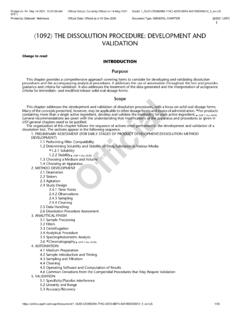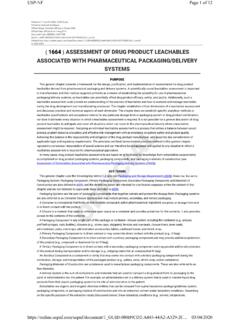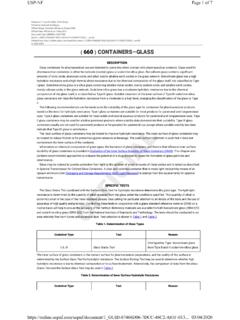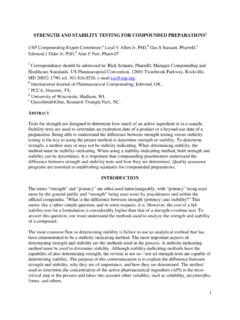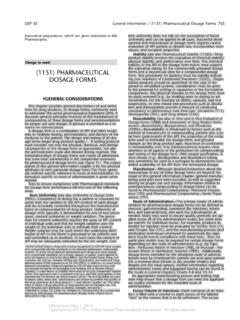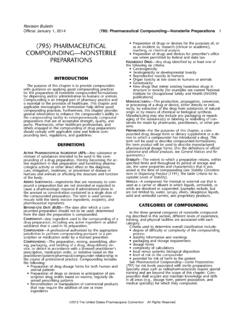Transcription of 1151 PHARMACEUTICAL DOSAGE FORMS - USP
1 Printed on: Fri May 14 2021, 10:26:22 AM Official Status: Currently Official on 14-May-2021 DocId: 1_GUID-431F93A9-1 FEC-42AE-8556-AA5B604B2E36_8_en-US. (EST). Printed by: Deborah Nishikawa Official Date: Official as of 01-May-2021 Document Type: GENERAL CHAPTER @2021 USPC. 1. 1151 PHARMACEUTICAL DOSAGE FORMS . Change to read: GENERAL CONSIDERATIONS. This chapter provides general descriptions of and definitions for drug products, or DOSAGE FORMS , commonly used to administer the drug substance (active PHARMACEUTICAL ingredient; API). It discusses general principles involved in the manufacture or compounding of these DOSAGE FORMS .
2 A glossary is provided as a nomenclature resource and should be used in conjunction with the Nomenclature A DOSAGE form is a PHARMACEUTICAL preparation consisting of drug substance(s) and/or excipient(s) to facilitate dosing, administration, and delivery of the content of the drug product or placebo to the patient. The design, materials, manufacturing, and testing of all DOSAGE FORMS target drug product quality. A testing protocol must consider not only the physical, chemical, microbiological, and biological properties of the DOSAGE form as appropriate, but also the administration route and desired dosing regimen.
3 These considerations, organized by route of administration, are detailed in Injections and Implanted Drug Products (Parenterals) Product Quality Tests 1 , Oral Drug Products Product Quality Tests 2 , Topical and Transdermal Drug Products Product Quality Tests 3 , Mucosal Drug Products Product Quality Tests 4 , Inhalation and Nasal Drug Products . General Information and Product Quality Tests 5 , and Ophthalmic Products Quality Tests 771 .2 The organization of this general information chapter is by the quality attributes of each particular DOSAGE form , generally without specific reference to the route of administration.
4 The following list provides the preferred DOSAGE form terms (USP 1-May-2021) used in official article titles. In addition to the preferred DOSAGE form terms (USP 1-May-2021) the Glossary contains other DOSAGE form (USP 1-May-2021) terms that al have been used in current official article titles but are not preferred and should not be used for new drug product titles. Official DOSAGE FORMS Used in Official Article Titles Aerosols Injections ci Rinses Capsules Inserts Shampoos Creams Irrigations Soaps Emulsions Liquids Solutions Films Lotions Sprays Foams Lozenges Strips Gases Ointments Suppositories ffi Gels Pastes Suspensions Granules Pellets Systems Gums Pills Tablets Implants Powders Tests to ensure compliance with USP standards for DOSAGE form performance fall into one of the following areas.
5 O. Dose Uniformity (See also Uniformity of DOSAGE Units 905 .) Consistency in dosing for a patient or consumer requires that the variation in the drug substance content of each DOSAGE unit be accurately controlled throughout the manufactured batch or compounded lot of drug product. Uniformity of DOSAGE units typically is demonstrated by one of two procedures: content uniformity or weight variation. The procedure for content uniformity requires the appropriate assay of the drug substance content of individual units. The procedure for weight variation uses the weight of the individual units to estimate their content.
6 Weight variation may be used where the underlying distribution of the drug substance in the blend is presumed to be uniform and well-controlled, as in solutions. In such cases, the content of the drug substance may be adequately estimated by the net weight. Content uniformity does not rely on the assumption of blend uniformity and can be applied in all cases. Successful development and manufacture of DOSAGE FORMS requires careful evaluation of the drug substance particle or droplet size, incorporation techniques, and excipient properties. stability Drug product stability involves the evaluation of chemical stability , physical stability , and performance over time.
7 The chemical stability of the drug substance in the DOSAGE form matrix must support the expiration dating for the commercially prepared DOSAGE FORMS and a beyond-use date for a compounded DOSAGE form . Test procedures for potency must be stability indicating (see Validation of Compendial Procedures 1225 ). Degradation products should be quantified. In the case of dispersed or emulsified systems, consideration must be given to the potential for settling or separation of the formulation components. Any physical changes to the DOSAGE form must be easily reversed ( , by shaking) prior to dosing or administration.
8 For tablets, capsules, oral suspensions, and implants, in vitro release test procedures such as dissolution and disintegration provide a measure of continuing consistency in performance over time (see Dissolution 711 , Disintegration 701 , and Drug Release 724 ). 1 Nomenclature Guidelines, 2 Marshall K, Foster TS, Carlin HS, and Williams RL. Development of a compendial taxonomy and glossary for PHARMACEUTICAL DOSAGE FORMS . Pharm Forum. 2003;29(5):1742 1752. 1/23. Printed on: Fri May 14 2021, 10:26:22 AM Official Status: Currently Official on 14-May-2021 DocId: 1_GUID-431F93A9-1 FEC-42AE-8556-AA5B604B2E36_8_en-US.
9 (EST). Printed by: Deborah Nishikawa Official Date: Official as of 01-May-2021 Document Type: GENERAL CHAPTER @2021 USPC. 2. Bioavailability (See also In Vitro and In Vivo Evaluation of DOSAGE FORMS 1088 and Assessment of Solid Oral Drug Product Performance and Interchangeability, Bioavailability, Bioequivalence, and Dissolution 1090 .) Bioavailability is influenced by factors such as the method of manufacture or compounding, particle size, crystal form (polymorph) of the drug substance, the properties of the excipients used to formulate the DOSAGE form , and physical changes as the drug product ages.
10 Assurance of consistency in bioavailability over time (bioequivalence) requires close attention to all aspects of the production (or compounding) and testing of the DOSAGE form . With proper justification, in vitro release testing ( , disintegration and dissolution) may be used as a surrogate to demonstrate consistent availability of the drug substance from the formulated DOSAGE . Release Profile Two principal categories of drug release are recognized: immediate-release and modified-release. Immediate-release is observed when no deliberate effort has been made to modify the drug substance release profile.



